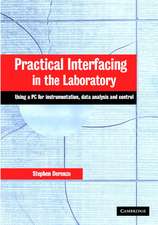Scalable Infrastructure for Distributed Sensor Networks
Autor S. S. Iyengaren Limba Engleză Hardback – 9 noi 2005
| Toate formatele și edițiile | Preț | Express |
|---|---|---|
| Paperback (1) | 940.57 lei 6-8 săpt. | |
| SPRINGER LONDON – 12 oct 2010 | 940.57 lei 6-8 săpt. | |
| Hardback (1) | 946.72 lei 6-8 săpt. | |
| SPRINGER LONDON – 9 noi 2005 | 946.72 lei 6-8 săpt. |
Preț: 946.72 lei
Preț vechi: 1154.54 lei
-18% Nou
Puncte Express: 1420
Preț estimativ în valută:
181.20€ • 195.59$ • 151.93£
181.20€ • 195.59$ • 151.93£
Carte tipărită la comandă
Livrare economică 19 aprilie-03 mai
Preluare comenzi: 021 569.72.76
Specificații
ISBN-13: 9781852339517
ISBN-10: 1852339519
Pagini: 216
Ilustrații: XIV, 194 p.
Dimensiuni: 155 x 235 x 14 mm
Greutate: 0.48 kg
Ediția:2005
Editura: SPRINGER LONDON
Colecția Springer
Locul publicării:London, United Kingdom
ISBN-10: 1852339519
Pagini: 216
Ilustrații: XIV, 194 p.
Dimensiuni: 155 x 235 x 14 mm
Greutate: 0.48 kg
Ediția:2005
Editura: SPRINGER LONDON
Colecția Springer
Locul publicării:London, United Kingdom
Public țintă
ResearchDescriere
Advances in the miniaturization of microelectromechanical systems have led to battery-powered sensor nodes that have sensing, communication and p- cessingcapabilities. Thesesensornodescanbenetworkedinanadhocmanner to perform distributed sensing and information processing. Such ad hoc s- sor networks provide greater fault tolerance and sensing accuracy and are typically less expensive compared to the alternative of using only a few large isolated sensors. These networks can also be deployed in inhospitable terrains or in hostile environments to provide continuous monitoring and processing capabilities. A typical sensor networkapplication is inventorytracking in factorywa- houses. A single sensor node can be attached to each item in the warehouse. These sensor nodes can then be used for tracking the location of the items as they are moved within the warehouse. They can also provide information on the location of nearby items as well as the history of movement of various items. Once deployed, the sensor network needs very little human interv- tion and can function autonomously. Another typical application of sensor networks lies in military situations. Sensor nodes can be air-dropped behind enemy lines or in inhospitable terrain. These nodes can self-organize th- selves and provide unattended monitoring of the deployed area by gathering information about enemy defenses and equipment, movement of troops, and areas of troop concentration. They can then relay this information back to a friendly base station for further processing and decision making. Sensor nodes are typically characterizedby small form-factor,limited b- tery power, and a small amount of memory.
Cuprins
1 Introduction 2 Sensor Node Deployment 3 Energy-aware Target Localization 4 Scalable Self-Configuration and Adaptive Re-Configuration 84 5 Location-Aided Flooding: An Energy-Efficient Data Dissemination Protocol forWireless Sensor Networks
Notă biografică
Krishnendu Chakrabarty is an Associate Professor of Electrical and Computer Engineering at Duke University. He has co-authored two books, edited a third book, and published over 150 papers in archival journals and refereed conference proceedings.
S. S. Iyengar (AAAS Fellow, IEEE Fellow, ACM Fellow) is the Roy Paul Daniels Professor of Computer Science and Chairman of the Department of Computer Science at Louisiana State University. He is the author/co-author of 13 books and he has published more than 280 papers in journals and refereed conference proceedings. He has given more than 50 plenary talks and invited lectures.He is the Editor-in-Chief of the International Journal of Distributed Sensor Networks (Taylor-Francis/CRC Press).
S. S. Iyengar (AAAS Fellow, IEEE Fellow, ACM Fellow) is the Roy Paul Daniels Professor of Computer Science and Chairman of the Department of Computer Science at Louisiana State University. He is the author/co-author of 13 books and he has published more than 280 papers in journals and refereed conference proceedings. He has given more than 50 plenary talks and invited lectures.He is the Editor-in-Chief of the International Journal of Distributed Sensor Networks (Taylor-Francis/CRC Press).
Textul de pe ultima copertă
Wireless sensor networks is a rapidly developing area. New applications are emerging and breakthroughs are being made in solving the underlying scientific problems.
The effectiveness of sensor networks depends largely on deployment strategies, self-organization capabilities, routing and information dissemination protocols, all of which contribute to the underlying network infrastructure.
Infrastructure Design for Sensor Networks is the first book to address basic infrastructure issues in wireless sensor networks. The book tackles the problems that must be addressed before sensors are deployed for surveillance, tracking, and other monitoring applications and the solutions described are scalable for large and dense sensor networks.
Included in a comprehensive treatment of the topic are:
techniques for deterministic sensor deployment for applications such as smart buildings and aircraft structural monitoring; techniques for ad hoc deployment for sensors, e.g., for military applications, determining, and environmental monitoring in inhospitable terrain;
self organization through self-configuration and adaptive reconfiguration when a large numbers of sensors are deployed in an ad hoc fashion;
energy-efficient information dissemination based on the new concept of virtual grids; and
infrastructure issues in energy-efficient data routing.
Infrastructure Design for Sensor Networks will be an invaluable reference source for researchers and graduate students on this topical and important subject.
The effectiveness of sensor networks depends largely on deployment strategies, self-organization capabilities, routing and information dissemination protocols, all of which contribute to the underlying network infrastructure.
Infrastructure Design for Sensor Networks is the first book to address basic infrastructure issues in wireless sensor networks. The book tackles the problems that must be addressed before sensors are deployed for surveillance, tracking, and other monitoring applications and the solutions described are scalable for large and dense sensor networks.
Included in a comprehensive treatment of the topic are:
techniques for deterministic sensor deployment for applications such as smart buildings and aircraft structural monitoring; techniques for ad hoc deployment for sensors, e.g., for military applications, determining, and environmental monitoring in inhospitable terrain;
self organization through self-configuration and adaptive reconfiguration when a large numbers of sensors are deployed in an ad hoc fashion;
energy-efficient information dissemination based on the new concept of virtual grids; and
infrastructure issues in energy-efficient data routing.
Infrastructure Design for Sensor Networks will be an invaluable reference source for researchers and graduate students on this topical and important subject.
Caracteristici
Only book to cover infrastructure aspects of sensor networks in a comprehensive fashion
Other books on sensor networks do not cover this topic or do so only superficially as part of a less-focussed multi-authored treatment
Includes supplementary material: sn.pub/extras
Other books on sensor networks do not cover this topic or do so only superficially as part of a less-focussed multi-authored treatment
Includes supplementary material: sn.pub/extras



















